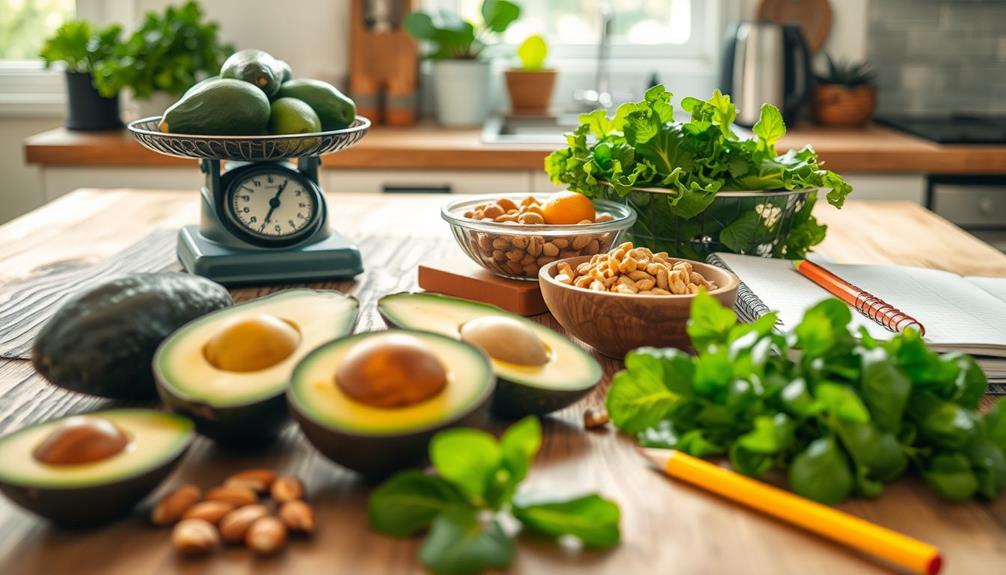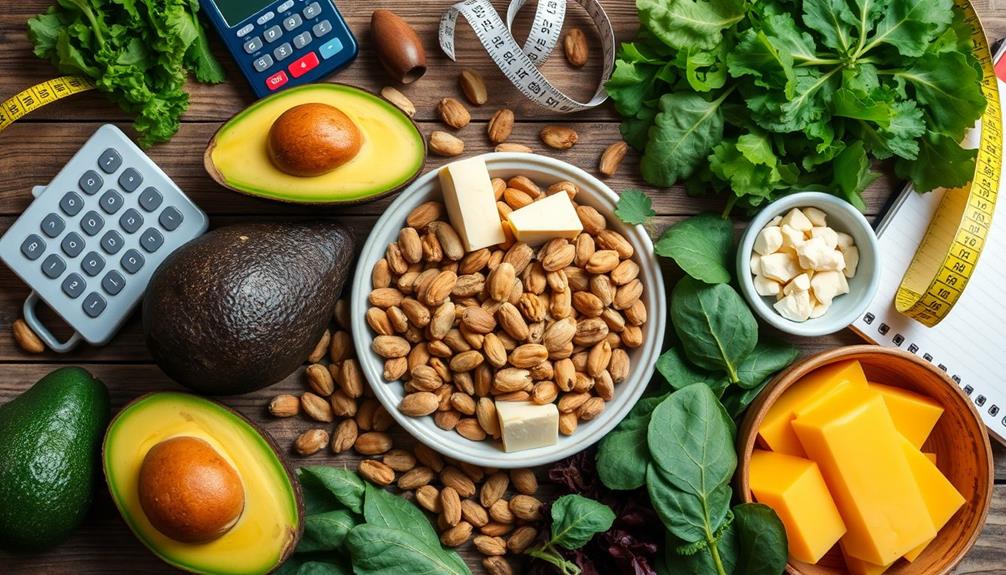Starting a keto diet for free is easier than you think. Focus on filling your meals with affordable, high-fat options like eggs, avocados, and canned fish. Limit your carbs to under 20 grams daily by choosing low-carb veggies like spinach and zucchini. Meal prep in bulk to save time and money, and consider using calorie-tracking apps to stay on course. Stay hydrated and bring keto-friendly snacks to help manage cravings in social settings. If you're curious about maximizing your keto journey, there are plenty of tips and tricks waiting for you to explore next. Don’t forget to consider fiber’s impact on keto. While it’s important to keep your overall carb intake low, incorporating fiber-rich foods like flaxseeds and broccoli can help support digestive health and keep you feeling full and satisfied. Focus on finding a balance that works for you and be open to adjusting your approach as needed. With some preparation and creativity, you can thrive on a keto diet without breaking the bank.
Key Takeaways
- Begin by understanding the ketogenic diet's macronutrient breakdown: 70-75% fats, 20-25% protein, and 5-10% carbs, with daily carbs under 20 grams.
- Focus on budget-friendly staples like eggs, canned fish, and low-carb vegetables to keep costs low while maintaining nutritional needs.
- Utilize free online resources, meal planning tools, and mobile apps to track your macronutrient intake and meal prep efficiently.
- Stay hydrated and consider electrolyte supplementation to alleviate symptoms of "keto flu" during the initial adaptation phase.
- Join online forums and support groups for motivation, recipe sharing, and tips on maintaining a keto diet on a budget.
Understanding the Keto Diet
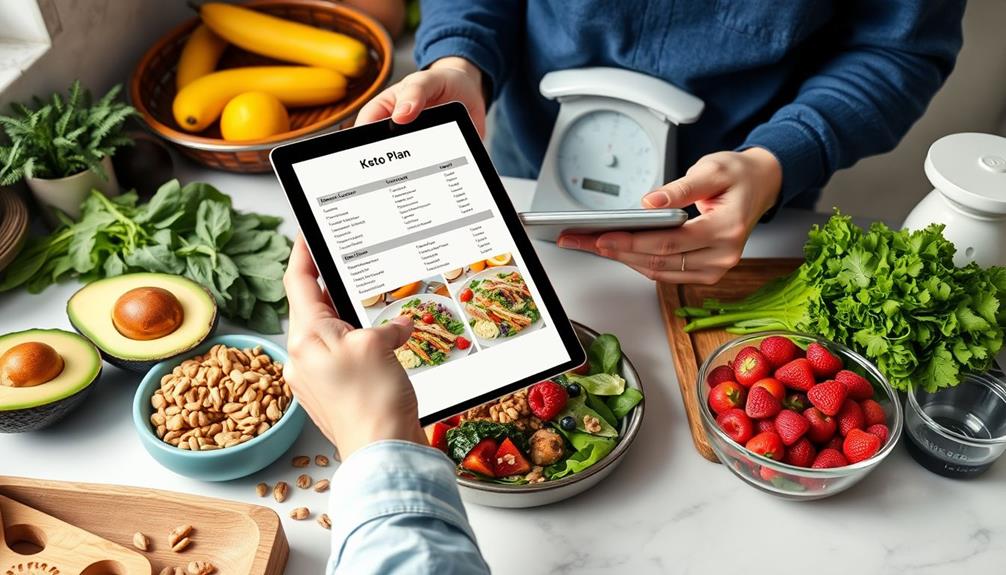
The Keto Diet is often misunderstood, but it's fundamentally a high-fat, low-carbohydrate eating plan designed to shift your body into a state called ketosis. In ketosis, your body burns fat for fuel instead of carbs, making it a powerful approach for weight loss.
Typically, the ketogenic diet consists of about 70-75% healthy fats, 20-25% protein, and only 5-10% carbs. To achieve this, you'll need to limit your carb intake to less than 20 grams of net carbs per day, cutting out sugars and starches. Additionally, incorporating foods rich in antioxidants, such as celery juice, can complement your diet by promoting hydration and supporting overall health.
Originally developed in the 1920s for managing epilepsy, the Keto Diet has recently gained traction for its potential benefits beyond seizure control. When planning your meals, focus on incorporating high-fat foods like avocados, nuts, and fatty fish while avoiding grains, sugar, and high-carb fruits.
However, be prepared for the initial adjustment period, often referred to as "keto flu," where you might experience fatigue, headache, or nausea as your body adapts.
Understanding these fundamentals will help you navigate your keto journey more effectively and set you up for success in reaching your health goals.
Benefits of Going Keto

When you start the Keto Diet, you might notice rapid weight loss that outpaces traditional diets, thanks to reduced appetite and fat burning.
This dietary approach can also promote better hydration, which is essential for overall kidney health, as highlighted in the Kidney Health Maintenance.
You'll also experience better blood sugar control, which can be a game changer for those managing diabetes.
Plus, many find that their mental clarity and energy levels improve as their brain taps into fat-derived ketones for fuel.
Weight Loss Acceleration
Often, people find that the Keto Diet kickstarts their weight loss journey like no other approach. The initial phase can lead to remarkable results, with many experiencing a reduction of 2-10 pounds in the first week alone.
This rapid weight loss is primarily due to water weight loss and the body beginning to burn fat for fuel. Additionally, understanding your budget can help you manage your grocery expenses while on the Keto Diet, making it a sustainable choice.
Here are some benefits you can expect from a Keto Diet Plan:
- Enhanced fat oxidation, making your body burn fat more efficiently
- Decreased hunger levels due to the satiating nature of fats and proteins
- Greater reductions in body fat compared to traditional low-fat diets
- Easier adherence to weight loss goals with reduced calorie intake
Blood Sugar Control
Achieving weight loss isn't the only advantage of the Keto Diet; it also plays a significant role in managing blood sugar levels. By minimizing carbohydrate intake to less than 50g per day, you can avoid those insulin spikes that often lead to unstable blood sugar levels. This is particularly beneficial for individuals with type 2 diabetes, as studies show that around 60% of participants experienced a reversal of their condition on the Keto Diet.
Here's a quick look at the benefits of the Keto Diet for blood sugar control:
| Benefit | Explanation |
|---|---|
| Improved Insulin Sensitivity | The diet encourages better insulin response. |
| Reduced Hemoglobin A1c | Lower levels indicate better long-term blood sugar management. |
| Decreased Glucose Dependence | Your body shifts to using fat for energy instead of glucose. |
| Stable Blood Sugar Levels | Fewer carbohydrate spikes lead to consistent energy levels. |
| Weight Loss | Even modest weight loss enhances glycemic control. |
Incorporating the Keto Diet into your routine can lead to significant improvements in blood sugar management, making it a smart choice for a healthier lifestyle.
Enhanced Mental Clarity
On the ketogenic diet, many people experience a remarkable boost in mental clarity. This improvement stems from the brain's ability to efficiently utilize ketones as fuel, especially when carbohydrate intake is low.
Studies suggest a correlation between dietary changes and enhanced cognitive function, similar to how astrology claims to influence personality traits and attractiveness. Here are some benefits you might notice:
- Enhanced focus and cognitive function
- Reduced symptoms of brain fog
- Improved productivity and mental performance
- Neuroprotective effects against cognitive decline
As your body adapts to the keto diet, it stabilizes blood sugar levels and reduces insulin spikes, leading to clearer thinking. Individuals with insulin resistance or type 2 diabetes often find relief from cognitive challenges, enabling sharper mental acuity.
While some may experience the "keto flu" during the conversion phase, once you're adapted, you're likely to enjoy increased overall productivity.
Research shows that ketones not only fuel your brain but also offer neuroprotective effects, potentially lowering the risk of neurodegenerative diseases.
Embracing the keto diet can lead to significant improvements in your mental clarity, allowing you to tackle daily tasks with renewed vigor and focus. So, get ready to unleash your mind's full potential!
Essential Foods for Keto
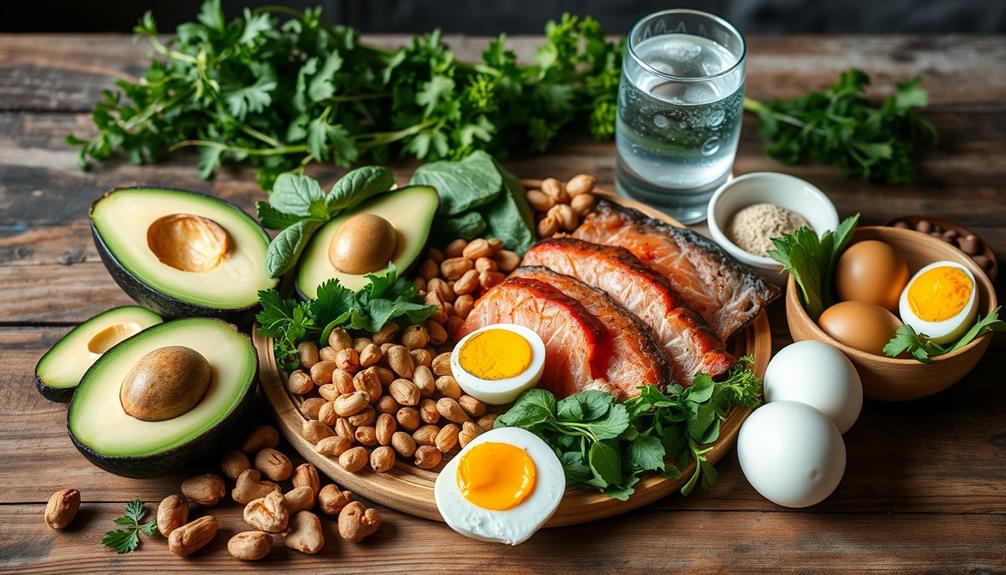
Starting your Keto diet means focusing on essential high-fat foods that will fuel your body and keep you in ketosis. You'll want to incorporate a balance of macronutrients, with high-fat options making up about 70-75% of your daily caloric intake. Here's a quick guide to help you with your meal prep:
| Food Category | Examples |
|---|---|
| High-Fat Options | Avocados, nuts (macadamia, pecan), olive oil |
| Protein Sources | Beef, pork, poultry, fatty fish (salmon, mackerel), eggs |
| Low-Carb Vegetables | Spinach, kale, broccoli, zucchini, bell peppers |
Don't forget to add full-fat dairy, like cheese and heavy cream, to your meals, but be mindful of their carb content. For keto-friendly snacks, turn to beef jerky, hard-boiled eggs, or low-carb protein bars to keep your net carbs below 20-50 grams per day. By focusing on these essential foods for keto, you'll be well on your way to achieving your dietary goals and enjoying delicious meals along the way!
Meal Planning on a Budget
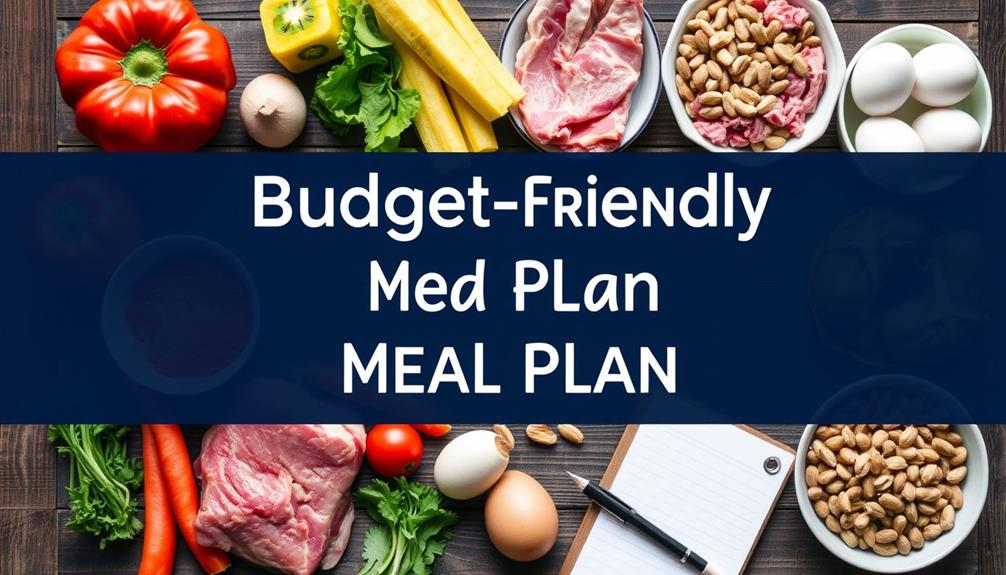
When you're starting a keto diet, meal planning on a budget is key to staying on track without overspending.
Focus on affordable staples like eggs, canned fish, and low-carb vegetables, which can keep your meals nutritious and cost-effective.
Additionally, consider incorporating natural remedies alongside conventional meals to enhance your diet.
Affordable Keto Staples
Eating keto on a budget is entirely possible with the right strategies in place. By focusing on affordable keto staples, you can enjoy nutrient-dense meals without breaking the bank. Incorporating gentle stretching can also help ease any discomfort you might feel while adjusting to a new diet.
Here are some tips to get you started:
- Stock up on affordable protein sources like eggs, canned tuna, and ground meats.
- Incorporate low-carb vegetables such as spinach, cabbage, and zucchini into your meals.
- Utilize bulk purchases of essentials like almond flour, coconut flour, and unsweetened peanut butter.
- Keep an eye out for seasonal produce to maximize savings.
Meal prep is a game changer. By cooking larger portions of meals like soups or casseroles, you can create quick, budget-friendly keto meals for the week ahead. This not only saves time but also guarantees you have keto-friendly ingredients readily available.
Don't forget to take advantage of sales for keto staples, helping you to maintain a balanced diet while keeping costs low.
With these strategies, you'll easily access essential nutrients and stick to your keto plan, all while being kind to your wallet.
Budget-Friendly Meal Prep
Meal prep can be a game changer for anyone looking to maintain a keto diet on a budget. Start by planning your meals for the week ahead, focusing on simple recipes with affordable ingredients like eggs, canned fish, and seasonal low-carb vegetables.
To stay active and healthy, consider incorporating aquatic exercise into your routine, which can complement your meal prep efforts. This approach keeps your costs down while ensuring you stick to whole foods.
Create a shopping list to prevent impulse buys, helping you prioritize budget-friendly keto foods. When shopping, consider buying in bulk for staples like nuts, seeds, and healthy oils; this often leads to significant savings over time.
Incorporate versatile ingredients such as cauliflower and zucchini in your meal prepping. These can serve as rice substitutes or pasta alternatives, maximizing their utility and minimizing waste.
Additionally, prep larger portions and freeze leftovers for future meals. This not only saves time but also helps you utilize ingredients fully, further reducing food costs.
Managing Challenges on Keto
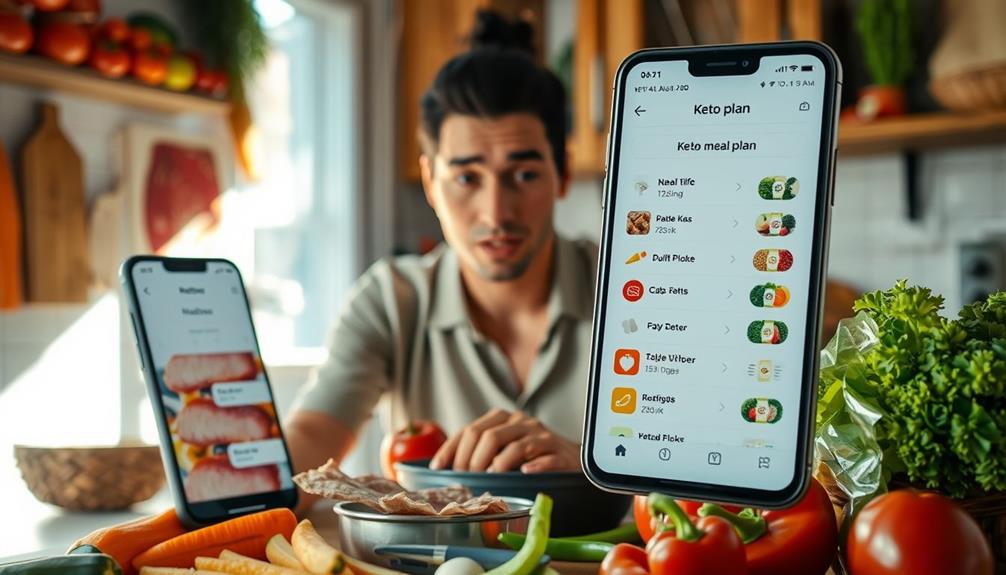
Steering through the challenges of the keto diet can feel intimidating, especially in the early stages. However, with some preparation and strategies, you can tackle them effectively:
- Stay hydrated to combat keto flu symptoms, and consider incorporating essential oils like eucalyptus oil for its decongestant effects if you're experiencing sinus issues.
- Plan meals to avoid high-carb foods.
- Bring keto-friendly snacks for social situations.
- Gradually reintroduce carbs after adaptation.
First and foremost, managing the keto flu is vital. Ensuring adequate hydration and electrolyte intake—especially sodium, potassium, and magnesium—can help alleviate fatigue and headaches.
Meal preparation is another important strategy; planning your meals in advance helps maintain adherence to strict macronutrient ratios and prevents you from reaching for high-carb foods.
When faced with social situations, don't shy away from reviewing menus beforehand. Look for protein-rich and non-starchy vegetable options, steering clear of bread and sugary sauces.
Keeping keto-friendly snacks like nuts, cheese, or hard-boiled eggs handy can curb hunger and keep you on track.
Lastly, once you adapt, consider gradual carb reintroduction to tailor the diet to your energy needs while still remaining in ketosis. This mindful approach will help you navigate the challenges and stay committed to your keto journey.
Helpful Resources and Tools
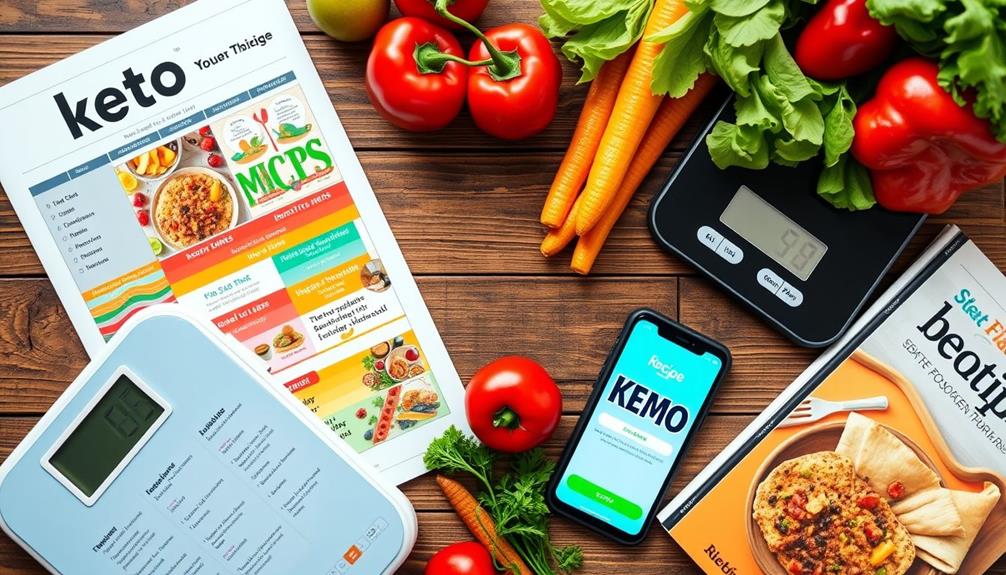
Steering through the keto diet can be a rewarding journey, especially when you equip yourself with the right resources and tools. Start by visiting reputable websites like the Cleveland Clinic and Mayo Clinic for expert insights on how to maintain your keto lifestyle.
Additionally, you can check out best ways to earn money online to fund your meal prep. Utilize meal planning tools and online calculators to track macronutrient intake, ensuring you hit the right ratios of fats, proteins, and carbohydrates.
Don't underestimate the power of community support. Join online forums and support groups dedicated to the keto diet, where you can engage in recipe sharing and receive motivational tips from fellow dieters. These connections can be invaluable for overcoming challenges that may arise along the way.
Explore free mobile apps designed specifically for the ketogenic diet. These can help you manage carb counts and discover keto-friendly foods while tracking your food intake effortlessly.
Frequently Asked Questions
How Do I Start My Keto Diet for the First Time?
To start your keto diet, limit carbs to under 20 grams daily for two weeks. Focus on high-fat foods, incorporate low-carb veggies, plan meals, and stay hydrated to ease the change and maintain energy levels. Additionally, consider incorporating intermittent fasting, as some keto research findings suggest that it can enhance the benefits of the diet. It’s also important to monitor your protein intake, as consuming too much can hinder ketosis. As you progress, pay attention to how your body responds and adjust your diet accordingly based on keto research findings.
What Is a Keto Diet Plan for Beginners?
A keto diet plan for beginners focuses on consuming under 20 grams of net carbs daily. You'll prioritize fats, moderate protein, and low-carb veggies, while meal prepping helps you stick to this lifestyle effectively.
How Can I Get Into Ketosis for Free?
To ignite ketosis, you'll want to starve your body of carbs like a fire deprived of oxygen. Slash your intake below 20 grams, embrace healthy fats, and stay active to accelerate this metabolic transformation.
How Do Beginners Get Into Ketosis?
To get into ketosis, you'll need to cut carbs to 20-50 grams daily, focus on high-fat foods, and maintain hydration. Incorporating intermittent fasting and regular exercise can also help speed up the process.
Conclusion
Starting a keto diet doesn't have to break the bank or be intimidating. With the right mindset and a few essential foods, you can glide into this lifestyle like a leaf on a gentle breeze. Embrace the benefits, plan your meals wisely, and tackle challenges with confidence. Remember, every step you take brings you closer to your goals. So, immerse yourself and enjoy the journey to better health—your future self will thank you!
